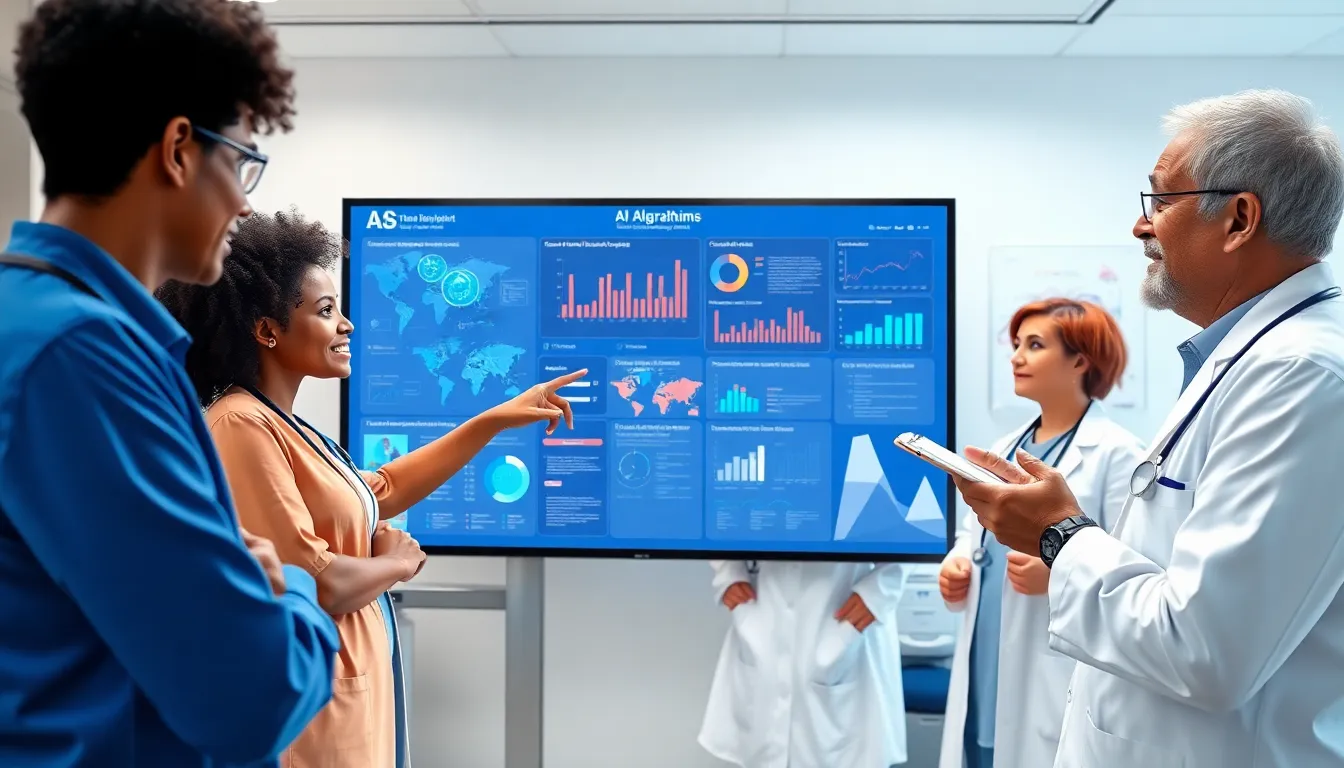The Internet of Things (IoT) is transforming the energy sector faster than you can say “smart meter.” Picture this: appliances chatting with each other while you sip your coffee, and your thermostat knows when you’re home before you even step through the door. It’s not just sci-fi; it’s the future of energy management.
Table of Contents
ToggleOverview of Internet of Things in Energy Sector
The Internet of Things (IoT) is revolutionizing the energy sector by enabling smarter resource management. Smart meters provide real-time data on energy consumption, allowing consumers to optimize usage and reduce costs. Sensors installed across power grids monitor performance, detect faults, and enhance reliability.
Connected devices play a prominent role in enhancing energy efficiency. Smart thermostats adjust heating and cooling based on occupancy patterns, leading to significant energy savings. Additionally, smart appliances communicate with each other, streamlining energy usage during off-peak times.
Integration of renewable energy sources benefits greatly from IoT technologies. Wind turbines and solar panels equipped with IoT sensors monitor weather conditions and performance metrics. As a result, stakeholders can maximize energy output and maintain system reliability.
Data analytics forms a crucial part of this ecosystem. Energy companies analyze data collected from connected devices to forecast demand and optimize supply chains efficiently. Predictive maintenance becomes feasible with IoT, resulting in reduced downtime for power generation facilities.
Consumer engagement has heightened through IoT’s influence. Mobile applications allow users to track their energy consumption in real-time, enabling informed decisions about usage. This proactive approach leads to responsible energy consumption and lower bills.
Regulatory and cybersecurity considerations are essential as IoT expands in the energy sector. Data security measures protect sensitive information while maintaining the efficiency and convenience IoT offers. Adopting strict regulations ensures technology adoption remains safe and sustainable.
The potential for innovation continues to grow, driving advancements in energy storage solutions and smart grid technologies. By leveraging IoT capabilities, stakeholders can create more resilient and efficient energy systems to meet future demands.
Key Applications

The Internet of Things (IoT) plays a vital role in transforming the energy sector through innovative applications that enhance efficiency and reliability.
Smart Grids
Smart grids utilize IoT technology to create an integrated network that optimizes energy distribution. These grids feature advanced sensors that monitor energy flow, allowing for real-time adjustments based on demand fluctuations. Improved communication between utility providers and consumers enhances service delivery and reduces outages. Data analytics in smart grids enables predictive maintenance, minimizing disruptions and prolonging the lifespan of equipment. Additionally, smart grids support the integration of renewable energy sources, making it easier to manage variability in power generation.
Energy Management Systems
Energy management systems leverage IoT capabilities to monitor and analyze energy consumption patterns. These systems provide users with detailed insights into usage trends, helping them identify opportunities for cost savings. By incorporating smart devices, organizations can automate energy-saving protocols, adjusting settings during peak and off-peak hours. Enhanced control over energy consumption leads to reduced costs and increased efficiency. Data-driven decision-making strengthens effectiveness in managing resources while promoting sustainability efforts within the energy sector.
Benefits of IoT in Energy
The Internet of Things (IoT) significantly enhances the energy sector by improving operational efficiency and data utilization.
Improved Efficiency
IoT technologies streamline energy management. Smart meters offer real-time energy consumption data, enabling consumers to adjust usage patterns effectively. Devices like smart thermostats optimize heating and cooling based on occupancy. Enhanced device coordination reduces energy waste, especially during peak times. Utility companies can monitor grid performance continuously, identifying issues before they escalate. Predictive maintenance minimizes downtime and extends equipment lifespans. Integration of renewable energy sources is facilitated by real-time data monitoring, optimizing energy output from solar panels and wind turbines. Overall, increased efficiency results in lower energy costs and reduced environmental impact.
Enhanced Data Analysis
Data analysis capabilities improve significantly with IoT adoption in the energy sector. Organizations gain insights into consumption patterns through analytics tools linked to smart devices. Detailed reporting identifies trends that guide energy-saving strategies. Real-time monitoring allows immediate adjustments to optimize performance. Data-driven decisions enhance investments in energy-efficient technologies. Utilities can leverage vast datasets for better demand forecasting, aligning energy production with consumer needs. Data aggregation from various sources supports compliance with regulatory standards and sustainability goals. The insights gained from predictive analytics strengthen the entire energy management process.
Challenges and Solutions
The adoption of IoT in the energy sector presents several challenges that require effective solutions to ensure secure and efficient integration.
Cybersecurity Risks
Cybersecurity risks pose significant threats to IoT systems within the energy sector. Devices connected to the internet may become entry points for cyberattacks, exposing sensitive data and disrupting critical operations. Companies must prioritize security measures, such as robust encryption protocols and regular software updates. Effective monitoring of network traffic enhances detection of unauthorized access attempts. Implementing multi-layered security strategies protects against potential breaches and builds resilience within IoT infrastructure. Furthermore, educating employees on cybersecurity best practices plays a crucial role in safeguarding company data.
Interoperability Issues
Interoperability issues arise when different IoT devices and systems fail to communicate effectively. These challenges hinder the seamless exchange of data and limit operational efficiency. To address this barrier, developers should adopt industry standards that promote compatibility among devices. Integration platforms facilitate communication between various systems, ensuring smooth data flow. Collaboration between manufacturers fosters the creation of universally accepted protocols. Investing in scalable solutions allows organizations to adapt as new technologies emerge and provides flexibility in managing diverse energy systems.
Future Trends
Emerging trends in the Internet of Things (IoT) are set to redefine the energy sector. Advanced analytics will continue to enhance energy management strategies, providing organizations with deeper insights into consumption patterns. Real-time data access will empower consumers and utilities alike, ensuring informed decisions about energy usage.
Smart grid technology is expected to evolve further, with enhanced machine learning capabilities optimizing energy distribution. Integration of artificial intelligence into IoT systems will facilitate proactive grid management, anticipating demand fluctuations before they occur. Furthermore, connected renewable energy sources like solar panels and wind turbines will communicate seamlessly with grid operators, enhancing resilience and stability.
Mobile applications are rising in popularity, supporting consumer engagement by offering personalized energy usage data. User-friendly interfaces will promote energy sustainability, leading to better cost management among households and businesses. Education on energy-saving practices will become more prevalent, encouraging responsible usage habits.
Cybersecurity measures must adapt to these advancements, as risks associated with IoT systems increase. Robust encryption will protect sensitive data, while continuous updates will secure devices against potential threats. Interoperability among various devices remains crucial to maximize operational efficiency; industry-wide standards can bridge communication gaps.
Investments in energy storage solutions show significant promise as IoT adoption increases. Enhanced storage capabilities will enable consumers to harness renewable energy more effectively, allowing for off-peak energy use. Utility companies will rely heavily on analytical tools to refine demand forecasting, aligning energy production with real-time consumer needs while ensuring compliance with evolving regulatory standards.
Collaborative initiatives among stakeholders will drive these innovations, fostering an ecosystem that prioritizes sustainability and efficiency within the energy sector.
The Internet of Things is undeniably reshaping the energy sector by enhancing efficiency and sustainability. As smart devices become more integrated into daily life, they enable consumers and utility providers to optimize energy usage with real-time data and analytics. This evolution not only streamlines energy management but also promotes responsible consumption through increased engagement.
Emerging trends in IoT promise to further transform the landscape, driving innovations in smart grid technology and energy storage solutions. With a focus on data-driven decision-making and collaboration among stakeholders, the energy sector is poised for a future that prioritizes efficiency and environmental stewardship. As these technologies continue to evolve, the potential for a more sustainable and resilient energy ecosystem becomes increasingly attainable.





